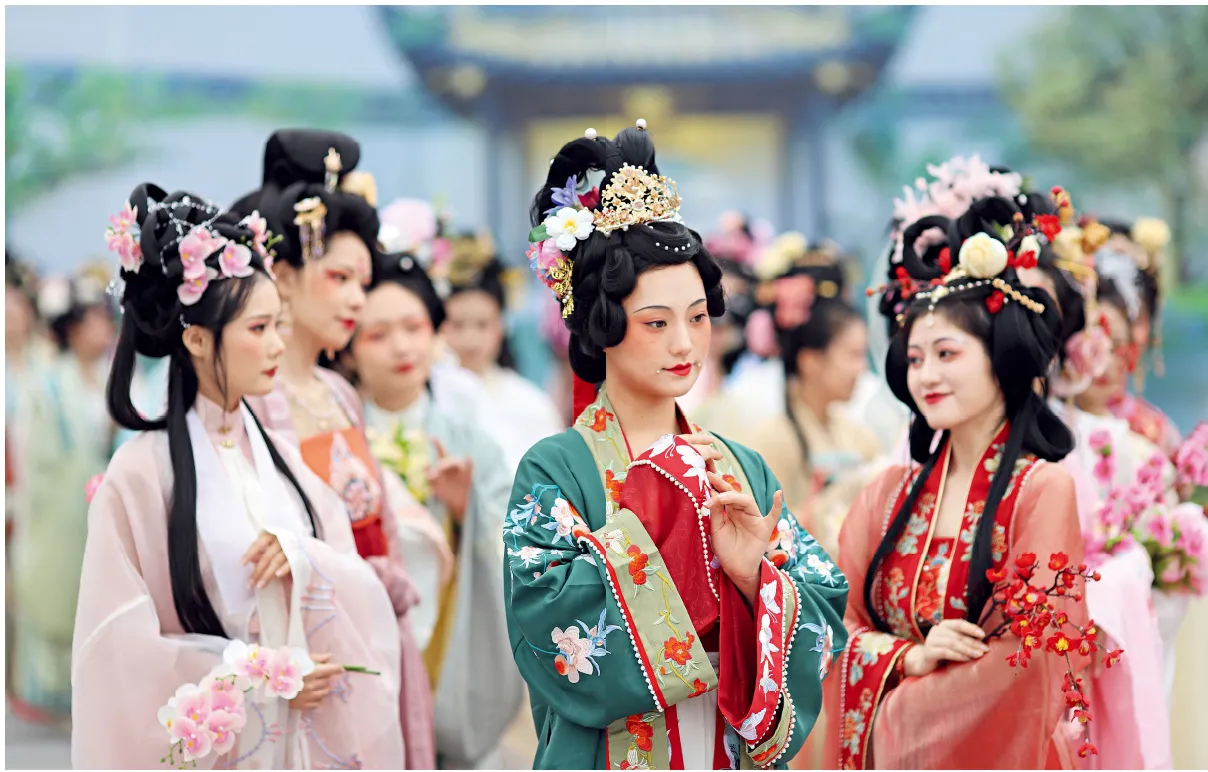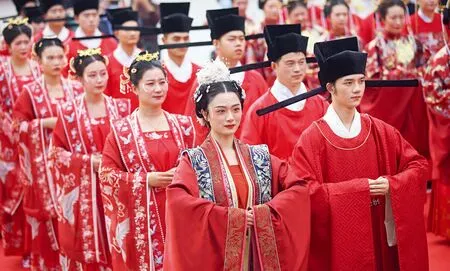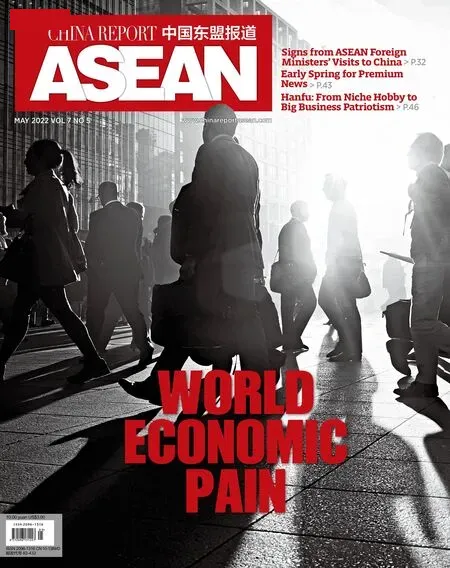HANFU:FROM NICHE HOBBY TO BIG BUSINESS PATRIOTISM
By Elsbeth van Paridon
The enduring popularity of traditional dress among young Chinese indicates a deeper attachment to cultural heritage

A group of young women wearing hanfu celebrate the traditional Chinese Flower Festival in Nanning,Guangxi Zhuang Autonomous Region,on March 6,2022.(VCG)
When the hanfu craze first exploded in 2018,many regarded the trend as a symbol of young China’s surging cultural confidence.The rise was driven by a mix of rising nationalism,local brand savviness,and social media amplifying the hype amongst China’s Gen Z.
Fast forward to 2022 and not only does the trend refuse to dwindle,but it is targeting the masses,ever-evolving in trendy and trending strength.
The enduring popularity of the dress code among young Chinese indicates a further and deeper attachment to their cultural heritage.
The Body of Work
Hanfu,meaning Han Chinese dress,is based on the ageold fashion traditions of the largest of all 56 ethnic groups in China:the Han (covering some 92 percent of the population).With the help of social media,a revival movement has emerged out of a desire to express national identity and the growing confidence of self-expression by Chinese youths.Shanghai-based content creator and popular key opinion leader (KOL) Shiyin is one of its poster girls,regularly sharing Instagram posts of her in flowing robes decorated with sumptuous needlework;China’s Twitter-like platform Sina Weibo reports that #hanfu had garnered over 4.89 billion views as of December 2021.
The traditional Han dress code declined in popularity during the Qing Dynasty (1644-1911) as the Manchu ruled the court.After the Qing Dynasty was overthrown,most Chinese people preferred Western-style clothes for the consideration of concise design which is more convenient for workwear,while others were keen on Western-centric fashion.Today,the garb is being reclaimed by millennial and,especially,Gen Z women,gradually moving from a subcultural aspect toward popular culture.
Evolving throughout several dynastical eras in Chinese history,the cultural clothing appears in different variations,which conveniently offer more choices for modern adoptees.Popular styles include Tang (618-907),Song (907-1279),and Ming (1368-1644) dynasties.The Ming is known for luxurious materials like satin and silk and often used gold leaf to enhance the sense of abundance.The layered silhouette is also accompanied by detailed embroidery that requires a high level of craftsmanship.The Tang panache is popular for its vibrancy,often employing bright colors.“It’s lively yet cute;and youthful,”wrote one aficionada on Weibo.
According to a 2019 report from Guangzhou-based market research firm iiMedia,the number of self-identified hanfu enthusiasts“saw a 73-percent jump to 2 million between 2017 and 2018.”
In the mere timespan of three years,that number has almost doubled,from 3.56 million in 2019 to over 6 million in 2020.And in 2019 alone,the industry made over 4.52 billion yuan (US$645 million) in sales.Fan following hit 6.89 million in 2021,with over 70 percent of fans being Gen Zs aged 16 to 24,and—big biz fact—overall sales had reached 10.16 billion yuan (US$1.597 billion)from 4.52 billion yuan (US$645 million) in 2019,”according to the December 2021 iiMedia stats.
Physical to Digital
In the past couple of years,young Chinese have elevated the dress code from a niche hobby to a generation’s tool of cultural expression while transforming it into a massive consumer market.Driven by a mix of influencer-propelled hype and heritage-inspired fashion knowhow,the rise of hanfu is a tale of young Chinese acknowledging their cultural heritage and taking a post-hegemonic attitude to carving out their own style path.
China’s passion for fashion has also turned this trend from just another online phenomenon into one of the hottest cultural themes nationwide.At Shanghai Fashion Week SS21 last year,hanfu shows were scheduled as a central part of events.Since 2018,the annual Xitang Hanfu Culture Week has been attracting more than 100,000 visitors every year and has become a hot hub for the spotting of new trends in the genre.Introducing dynastic carnivals,runway shows,weddings,coming of age ceremonies,the festival advocates the rule,integrity,balance,and harmony of the Han clothing culture.
On Douyin,China’s version of TikTok,the #hanfu hashtag has thus far garnered over 300 million views,but fashion content is only a minor slice of that pie.Most posts with the tag cover traditional cultural hobbies practiced while dressing up such as martial arts,finger dances,tea pouring,or myriadother things.This brings us back to the influencer who produces content on topics ranging from cultural clothing to a full-scale revival of Chinese tradition.Shiyin,who was featured in American Vogue’s March 2021 issue as the face of China’s hanfu movement,now has launched a short video series on Chinese luxury traditions of yore.

A girl dressed in hanfu performs archery rituals in Luoyang,Henan Province,to celebrate the traditional Dragon Boat Festival on June 12,2021.(IC PHOTO)

A hanfu-themed group wedding in Xuzhou,Jiangsu Province,September 29,2021.(YANG BO)
According to Alibaba,over 20 million people got their hands on some imperial style last year on e-commerce giant Taobao.In July 2019,Alibaba launched its Gutao app,a social platform dedicated to hanfu shopping to meet skyrocketing consumer interest.Big biz fact:Shisanyu,a label founded in 2016,climbed to the top of the site’s bestselling brands list last year and is now worth US$16 million.
The Future is Fusion
For many fervent fans,wearing the traditional style is a nod to their cultural identity and symbolizes their inspiration to delve deeper into that heritage.
China’s younger generations want to wear something according to their own traditions,those outside of the consolidated Western beauty standards.Though there is a sense of national pride (in the cultural sense) involved,a resistance to being dragged across the board,a resistance to homogenization,not some type of full-fledged politically fueled patriotism,draws the Gen Z eye to hanfu.
Another advantage is“how the embroidery,wide sleeves,and loose robes will make you look elegant,no matter what your body shape may be,”according to another devotee who wishes to remain anonymous.
As we live in an ever-faster-trending digital era,the question beckons:How can traditional design better suit a modern lifestyle?
The trend of blending traditional Chinese elements into one’s daily fashion routine is here to stay—among the younger generations.On prevalent short video platform Bilibili,popular hanfu KOL content now includes“everyday guides”and“genderless,streetwear options”as more and more youngsters match their dynastical throwback pieces with Balenciaga sneakers and Supreme hoodies.Travel vlogs entitled“Wearing hanfu in Rome/London/…,”where young bloggers upgrade their global wardrobe game by adopting traditional dress as their go-to uniform when visiting Western tourist destinations,have also become a popular genre.
Hàn yáng zhé zhōng,or“middle way between Chinese and Western styles”within hanfu circles,is the concept of a journey to discover the optimal eclectic mix for each individual by pairing traditional Chinese poise with a bit of Western pizzazz.It’s a red-hot fusion.

